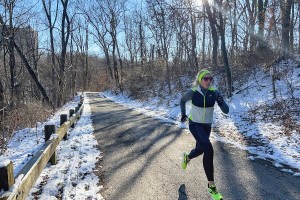Expert Advice: How to Prevent Yoga Injuries with Strength Training
It’s better to bend than to break—so the proverb goes. But what if the bending causes the breakage?
Earlier this month the New York Times reported on a problem within the yoga community: the rise of a condition called femoroacetabluar impingement (FAI). Because of their naturally greater flexibility, female yogis are much more prone to developing this painful condition, in which the bones and cartilage of the hip joint become damaged or inflamed. In severe cases, women’s hips must be surgically repaired, or even replaced.
One of the best ways to prevent FAI and ensure years of fruitful yoga practice is to strengthen the muscles and connective tissue surrounding the hip joint: the glutes (butt muscles), abductors (top-of-the-butt muscles) and adductors (inner thigh muscles), to name a few.
And believe it or not, a simple resistance-training program will not only prevent hip injury, it will also make you more flexible, since flexibility is often limited not by the pliability of the stretched muscle, but by the strength of the opposing muscle to safely hold the end range of motion. In other words, if you’re not building strength, your body will simply not allow you to achieve a position that it doesn’t have the strength to support.
To build real-world strength, you have to use real-world weight. Here are three moves you can use to strengthen your hips and build muscle. But don’t worry—this program won’t make you bulk up. It’ll complement the lithe physique you get from a regular yoga practice.
1. Wide-stance kettlebell deadlift
http://youtu.be/o1sSqumSo2U
How to do it:
a. Stand directly overtop a heavy kettlebell with your feet slightly wider than shoulder width. Make sure the kettlebell is directly between your ankles. Turn your toes out as much or as little as you like, but no more than 45 degrees.
b. Keeping your shins perfectly perpendicular to the floor, begin to sit back, as if reaching your glutes for a chair a few feet behind you. This should begin to create a stretch in your inner thighs and hamstrings. Don’t let your knees cave in! Rather, use your top-of-the-butt muscles to pull them out over your pinky toes. Keep sitting back until you reach straight down and grasp the handle of the kettlebell.
c. Grasping the kettlebell firmly, lift your chest up, squeeze your armpits tight, and push your heels through the floor to stand tall. Once you’re standing fully erect, press your pelvis into your forearms hard, and tuck your tailbone under slightly to really contract the glutes.
d. Slowly reverse the motion to place the kettlebell back between your ankles. That’s one rep.
These are best done heavy, for sets of five reps. Do three to five sets with two to three minutes rest in between. Your inner thighs and butt may be sore the next day. If you feel like five reps is too easy, go heavier—but keep your form strict!
2. Single-leg hip extension
http://youtu.be/N5Zio8S5UdQ
How to do it:
a. Lay down perpendicular to a workout bench, or even a few feet in front of a chair.
b. Put one foot up on the bench or chair, weight on the heel. Pull the opposite knee to your chest and hold it there with your hands.
c. Harden your abs to press your lower back firmly into the floor, then push your heel into the bench to lift your entire torso off the floor. Push your body up as high as you can, and again, when you reach the very top, slightly tuck your tailbone under to really contract the glutes. Lower yourself back down gently. That’s one rep.
These are best done for higher reps with a strict, controlled tempo after your heavy deadlifts. Do 10 to 20 reps on one leg, then the same number on the other leg. Repeat for three to five sets. These burn!
3. Suitcase carry
http://youtu.be/ktHCun4fJwM
How to do it:
a. Deadlift a medium-sized kettlebell or dumbbell and hold it to one side, like a suitcase.
b. Stand tall—try to touch the ceiling with the top of your head—and squeeze your armpits tight.
c. Maintaining perfect posture, walk forward 20 paces. No leaning to the side!
d. Switch hands, than walk 20 paces back.
These are best done last, for three to five sets of 20 paces out and 20 paces back. If you feel these in your obliques, you’re doing it right. If you find yourself leaning to one side and unable to correct it, use a little less weight.
Do these three exercises for the prescribed sets and reps two to three times per week for four to six weeks. You’ll be stronger, more resilient to injury, and enjoy an enhanced yoga practice as well.
………..
Marshall Roy is the owner of RISE gym in King of Prussia, a kettlebell and barbell studio offering personal training and group strength & conditioning classes. During his career he’s trained rugby players, triathletes, news anchors, Brazilian jiu-jitsu fighters, middle-aged men and women, the obese, and even figure competitors. Learn more about what RISE has to offer at www.RISEgym.com.



